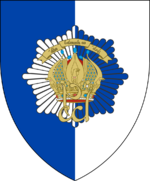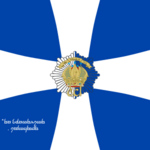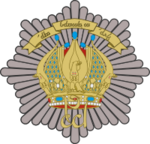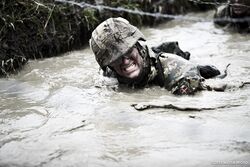Royal Life Guard
| The Royal Life Guard | |
|---|---|
| Den Kongelige Livgarde | |
 Coat of Arms | |
| Active | 14 May 1621 – present |
| Country | |
| Allegiance | |
| Branch | |
| Type | Royal Guard |
| Role | 1. Bataljon Ambrosian Guard – Mechanized infantry/Guard of honour 2. Bataljon Mounted Lifeguard – Mechanized infantry/Official Escorts 3. Bataljon – Training 1. Company Royal Guard Hussars – Guard of honour 2. Company Guards Company – Guard of honour |
| Size | 3 Battalions and 2 Companies |
| Part of | Army Tactical Staff |
| Garrison/HQ | Kolbæk The Citadel |
| Nickname(s) | Livgarden, Garden, Ponypiloter |
| Patron | Thane of Elsbridge Duke of Austevoll |
| Motto(s) | For Konge og Folk (For King and People) Altid Først (Always first) |
| Stable belts of the infantry and cavalry | |
| March | Asgård March And Here comes Jens with the banner |
| Mascot(s) | Garder Jens |
| Anniversaries | Siege of Asgård 7 October |
| Engagements | War of the Tundra Ambrosian War of Liberation Northern Wars Great War of the North Continental War War of the Njord |
| Commanders | |
| Chief of the Foot | |
| Chief of the Horse | |
| Grand Commander | |
| Insignia | |
| Standard of the Royal Life Guard |  |
| Cap Badge of the Royal Life Guard |  |
The Royal Life Guard, (Tynic: Den Kongelige Livgarde) is a brigade-sized unit of the Royal Sjealandic Army founded in 1621 by Valdemar VII in honour of his grandson Frederik. It is one of two units in the RSA staffed almost exclusively by conscripts. The primary task is to provide a number of soldiers from the various guard companies to serve as a guard/ceremonial unit to the Court and Government, while training the conscripts for various functions in the mobilisation force. It is the most senior military formation in the Royal Sjealandic Army and consists of both infantry and cavalry formation. While the name Den Kongelige Livgarde technically applies to the entire formation, informally only the Guard Company is called of that name, the other formations having their own names and traditions. Originally the Royal Life Guard was only a mechanized infantry formation, but after the 2004 military reform all ceremonial units of the RSA were transferred into the Royal Life Guard.
Names
The formation has had various names throughout its history, same with the formations it took over in 2004. The formation was created with the name Ærkekongens Livregiment til Fods (The Archkings Life-regiment of the Foot), with the first commander being Troels Ahlefeldt. The formation would see several name changes until the outbreak of the Great War of the North when the Den Kongelige Livgarde til Fods (The Royal Lifeguard of the Foot) and Den Kongelige Livgarde til Hest (The Royal Lifeguard of the Horse) were combined into the modern name known today in response to Swastrian incursions towards Asgård. The Ambrosian Guard and Guard Hussars have seen similar name-changes throughout history, but were allowed to keep their names once laid under the command of the Life Guard.
| Ærkekongens Livregiment til Fods | The Archking's Life Regiment | 1621 | – | 1693 |
| Hans Kongelige Majestæts Garderregiment til Fods | His Royal Majesty's Guard Regiment | 1693 | – | 1722 |
| Vor Garde til Fods | Our Guard of the Foot | 1722 | – | 1740 |
| Den kongelige Livgarde til Fods | Royal Life Guard of the Foot | 1740 | – | 1861 |
| Den kongelige Livgarde | Royal Life Guard | 1861 | – | 1917 |
| Livgarden | The Life Guard | 1917 | – | 1963 |
| Den kongelige Livgarde | Royal Life Guard | 1963 | – | Present |
History
Creation
First battles
Modern history
Organization
Currently the Royal Life Guard is organized into:
- Brigade Staff (Garrison Support) under Chief of Staff major Håkon Valdemar Hulder
- I Battalion/Ambrosian Guard (I/Livgarden) under major Håkon Valdemar Hulder
- II Battalion/Mounted Life Guard (II/Livgarden) under major Anne-Sofie Gyldenlund
- III Battalion/Training (III/Livgarden) under major Frederik Niels Hansen
- I Company/Royal Guard Hussars (I/Palæ) under captain Søren Peter Østergaard
- I Company/Guard Company (II/Palæ) med Drummers Corps under captain Liljan Gudmunsdottir
- Royal Life Guard Music Corps under captain Ragval Erling
III/Livgarden is a the largest of these units, with around 900 soldiers at any time, and serves to give the recruits the Basic Education of the Army (Hærens Basisuddannelse/HBU), a five month long military education, following this recruits are transferred to the specific chosen units to finish their education and begin service.
Personnel
Youths that have been called up to serve their conscription in the Royal Life Guard at the guard-barracks in Kolbæk, begin their one year service in III/Livgarden, where the recruits are divided into 6 different companies and recieve basic training for five months. Following this the recruits are transferred to their chosen units to recieve an additional 1 month education in parade drilling and for some horse riding before transferred into service. Following this conscripts serve for 6 months in their formation.
During HBU the conscripts undergo three 3 day exercises and one final 5 day exercise which acts as their examination. The first three exercises respectively focus on: defending an objective, attacking an objective and combat in a civilian enviroment. The final exercise, the Kings Journey (Kongstur), combine all the former exercises and typically involve most of the area around Kolbæk along with neighbouring villages and ends with the final gruelling Kings March (Kongsmarch), which pushes the recruits to the breaking point. During the Kongstur recruits recieve only half a days ration to be spread out over all five days and recieve only on average 3 hours of sleep a day. Upon finishing the exercise the recruits are march through the gates of Kolbæk Barracks and are congratulated by all their colleagues except for the conscripts currently on guard, and typically locals also come to congratulate them. They are not allowed to sleep once the exercise ends, and instead dress in the M/69 Parade Uniform and assemble on the parade-grounds of the palace. Here each recruit is given his Guard-mark (Gardermærke, the monarchs monogram and crown) by his commanding Lieutenant along with the regimental belt. The belts colours symbolize:
- Thick red strips in the top and bottom (symbolizes that they are now official soldiers, ready for action.)
- Thin black strip above and below the red strip (Represents the comrades lost in former wars)
- Two thich strips in the middle, blue and white (Official Colours of the Royal Life Guard)
Additionally the commanding officer of each company may award a Brigade-Flag to a platoon that has shown exceptional commitment to their comrades and fulfilling their duty.
Guard Company
Duties
The Guard Company is the titular Life Guard of the Royal Life Guard. Consisting of around 450 Conscripts, the guard company is responsible for the security and well-being of the Royal Family and their palaces. The Guard Company provides a permanent guard at Asgård Palace, Kastellet and Søskøn Palace. In addition to this they move with the Monarch whenever the Monarch moves to another palace. The Guard Company also provides an Honour Guard at all official happpenings involving the monarchy, typically in the red galla uniform to contrast their standard dark blue. These include visits from ambassadors, royal weddings and namings.
While they seem to be a ceremonial guard the Guard Company functions as a full on military deployment, and all guardsmen are taught how to survey the palace grounds and identify potential threats. When on guard the gun is always loaded with live rounds and with a bullet in the chamber, ready to fire. In cooperation with police the Guard Company recieves training in riot control and crowd control so to pacify a potential crowd. The Guard Company is armed with a Gevær M/04, Bajonet A/11, Feltsabel A/11 and a KV/9 Kamppistol.
The Guard Company consists of three Guard Formations, 1. Formasjon, 2. Formasjon and 3. Formasjon. Of these 1. Formasjon consists of the tallest guardsmen and the 3. the shortest. With a minimum required hight of 180 centimeters, the shortest guards are still quite tall. Small coloured insignia on their shoulderstraps along with the colour of the sabre decoration denote which Guard Formation a soldier belongs to. The Guard Company is on guard all day, every day, with all guards starting at 12 in the day and continuing for 24 hours. During these a Guardsman is on watch for two hours, followed by 4 hours of rest before he is on Guard again. However if a situation arises it is typically guards resting who will be called up to investigate.
A typical week for the 1. Guard Formation would look like:
- Monday: Guard begins
- Tuesday: Guard ends
- Wednesday: Ø-day*
- Thursday: Guard begins
- Friday: Guard ends
- Saturday: Day off
- Sunday: Guard begins
Ø-Day is used to practice Parade drills, however after 1-1½ months, when the guards have shown enough proficiency they will be allowed to use the Ø-day as a day off. Ø-days are never in the weekend, as these are either reserved for guards or free time. Not all soldiers in a Guard Formation participate in the guard, some function as reserves or have the day off. Typically a guard formation starts with 6 reserves but gradually can decrease these to 4.
King's Guard
The Guard Company has three sizes of guard units and parades, depending on who is in residence at Asgård Palace. When His Majesty the Archking is in residence the Guard is the largest and is called the King's Guard. Guards of similar sizes are held at whatever palace His Majesty is at when not in residence at Asgård Palace. When a King's Guard is in session the palace is guarded by 12 guards out of a total of 36 Guards. These consist of 4 Guards clockwise in the inner court of the palace and one at the entrance to the central. 2 Guards are stationed at the main gate, with 1, the commanding guard, at the smaller. The remaining guards patrol the outside of the palace and the Royal Gardens in pairs. A King's Guard parade consists of:
- Guard Commander: Major
- Second in Command: Captain or First lieutenant
- Flag: Battalion Galla-colours
- Standard-Bearer: Sergeant first class
- Guard Force: 36 Guards
- Additional parade members: 18 Guards
- Musical Corps: 42 Musicians
- Drummers Corps: 16 Drummers
Lieutenant's Guard
If another member of the Royal Family, but the Archking is in residence it is called a Lieutenant's Guard. When a Lieutenant's Guard is in session the palace is guarded by 12 Guards out of a total of 54 Guards. These consist of 4 Guards clockwise in the inner court of the palace and one at the entrance to the central. 2 Guards are stationed at the main gate, with 1, the commanding guard, at the smaller. The remaining guards patrol the outside of the palace and the Royal Gardens in pairs. A Lieutenant's Guard parade consists of:
- Guard Commander: Captain
- Second in Command: First lieutenant
- Flag: Standard Colours
- Standard-Bearer: Sergeant first class
- Guard Force: 36 Guards
- Drummers Corps: 16 Drummers
Palace Guard
A Palace Guard is the smallest and is when none from the Royal Family is in residence. When a Palace Guard is in session the palace is guarded by 8 guards out of 24. These consist of 4 Guards clockwise in the inner court of the palace and one at the entrance to the central. 2 Guards are stationed at the main gate, with 1, the commanding guard, at the smaller.
- Guard Commander: Sergeant first class
- Guard Force: 54 Guards
Uniform
The Uniform worn by the Guard Company while on duty consists of bearskin headdresses, dark blue tunics and light blue trousers with white stripes. The ceremonial uniform, worn on special state occasions, substitutes a scarlet tunic for the dark blue. In addition a sabre bag and bandoliers are worn. The bearskin is decorated with the bronze cap badge of the royal life guard. In addition symbolic infantry sabres are worn by the rank and file and held in hand by the officers.
Mounted Life Guard
Duties
The Mounted Life Guard (Kongelige Livgarde til Hest) is the equestrian arm of the Royal Life Guard and consists of around 120 conscripts and 80 horses divided into to mounted squadrons. The Mounted Life Guard was first established in 1808 as a separate Life Guard for when the monarch was travelling, but was united with the Guards Company after the Great War of the North so to better coordinate their common duties. The Mounted Life Guard provides security and escorts for the royal family when travelling and as a ceremonial escorts to them and foreign visitors. Typically when the Guards Company provides the honour guard the Mounted Life Guard provides the mounted escort.
The Mounted Life Guard typically recieves similar training to the Guard Company, but where the Guard Company primarily recieves training in defence and securing the area, the training of the Mounted Life Guard focuses more on securing the royal family, and as such they recieve specialized training as sharpshooters and drivers, so those not escorting the target may act as snipers along some routes and others stand ready as escape drivers in secured vehicles. When mounted the Mounted Life Guard is only armed with the Feltsabel A/11 and a KV/9 Kamppistol while those not mounted typically are armed with a Karabin M/06 or a Finskyttevåben M/01.
When an escort is in action 60 Life Guards will saddle up and form an escort surrounding the target. Usually 20 in the front and 40 in the back. Riding in 3-2-3 formation in the back and 1-3-1 in the front. Of the Life Guards not mounted 10 will drive in front of and behind the caravan in unmarked vans with weapons ready in case a situation will arise, the remainder are spread out along the route in cooperation with regular police to secure the route. When departing and arriving the Mounted Life Guard will typically play their Signalmarch which conscripted members are taught to play. Every wednesday those not on duty will ride through the city to make sure the horses are accustomed to the bustle of the city, and the train the Mounted Life Guards in riding through an urban enviroment.
Uniform
Like all other military formations the mounted lifeguard wears the Uniformssystem M/110 uniforms when not in ceremonial service. Their ceremonial uniform consists of:
- A Blue Dolman: The same original one introduced in former cavalry regiments in 1762.
- A Red Pelisse (jacket): The same original one introduced in former cavalry regiments in 1762.
- Blue Riding Breeches: The current light blue breeches with a white stripe along the outseam were introduced in 1828.
- A sabretache (pouch): In the colours of the regiment, with the royal monogram. It is the only uniform in the world to still use it, and has been in use since the formation was founded.
- A shako with a cordon and pompom made of tail hairs for NCOs and enlisted, officers have white buffalohair. There are two colours for pompoms, red for the Bugle Corps while the rest have white.
- A shabraque (saddlecloth): In the colours of the regiment, with the royal monogram. It remains mostly unchanged since 1828.
- A Bridle: The bridle has cowries woven into it. It was meant to make the horse look like a skeleton, but also to protect the horse from sabre cuts and to signify wealth.
The motto of the Mounted Life Guard is written on their cap badge, which is shaped like a horse-head. The badge exists in to variantes, silver and gilded, or just silver. Silver and gilded are only used by Mounted Life Guards who have passed their recruit time.
Ambrosian Guard
Duties
The Ambrosian Guard is the Honour Guard of the Sjealandic Government and is exclusively staffed with citizens who can prove to be at least a quarter Ambrosian or Ambrosian citizens who swear alliegance to the Guard. The Guard was established in 1504, and is the oldest Guard in the formation. Originally the guard consisted of Ambrosians serving the Sjealandic crown, as the two countries were united at the time and many Ambrosians were staunchly loyal to the monarchy. When Ambrose rose in revolt in 1673 the Ambrosian Guard remained one of the most loyal regiments in the Royal Sjealandic Army, with over half the regiment dying in the Battle of Duncansby to allow for the escape of the King. When captured none of the Guardsmen would surrender or renounce their alliegance to the Sjealandic Crown, earning them a place as heroes in Sjealandic national folklore.
From the establishment of the 1829 Sjealandic Constitution till today the Ambrosian Guard have been responsible for guarding the Government of Sjealand and its officials. The Ambrosian Guard have permanent postings at the Rigsdag, Supreme Court, the residences of all cabinet ministers and the Gudstaler and all war memorials in Asgård. With 500 conscripts the Ambrosian Guard is the largest of the formations in the Royal Life Guard and they are divided into 4 Companies. Unlike other formations in the Royal Life Guard, the Ambrosian Guard has all commands issued in Anglish, however the working language is still Tynic.
Soldiers of the Ambrosian Guard are armed with the same weapons as the Guard Company except a lack of sabres and that those guarding the Rigsdag are armed with the Gevær M/1889. Where-as the Guard Company will typically perform their operative duties in ceremonial dress the Ambrosian Guard is usually the first to respond in combat dress, as seen during the ethnic conflicts in Hvidland and during the 2011 terrorist attack where the Ambrosian guard changed into full combat gear in all positions and brought in LMG´s.
Uniform
The Ambrosian guard carries a dark parade-uniform in Ambrosian style, which has remained almost unchanged the last centuries. It consists of black trousers with two white stripes, a navy-blue jacket with green epaulettes and a red passepoil. In continuation with the Ambrosian style, the guard wears a bowlerhat with a pompom of white buffalo-hair. Originally the bowlerhat was decorated with feathers, inspired by the Montecaran Coraçìeri which had impressed Archqueen Wilhelmina at a state visit so much that she insited that the Ambrosian guard wear similar hats. After her death the feathers were exchanged for buffalo-hair.
Unlike all other military units in the Royal Sjealandic Army except for the other formations of the Royal Life Guards, the Ambrosian guard are not required to wear their berets, and are instead instructed to wear side caps witha pompom and stripes when performing duties outside of their ceremonial guards. Recruits wear berets until they have passed their training and have become guardsmen. They, like the rest of the guards company, use gilded metal buttons and marks on their uniforms.
Guard Hussars
Duties
Uniform
Mottos
Maintenance
Traditions
Alliances
 Jorland and Lothican - Defenders of the Commonwealth - Bond of Friendship and Alliance
Jorland and Lothican - Defenders of the Commonwealth - Bond of Friendship and Alliance Union of Nautasian Islamic Republics - Guard-Companions of the Supreme Leadership - Bond of Cooperation
Union of Nautasian Islamic Republics - Guard-Companions of the Supreme Leadership - Bond of Cooperation
- ↑ Laursen, Ole (22 April 2014). "Historical Overview of Royal Life Guards". Wadschier. Retrieved 5 June 2017.







